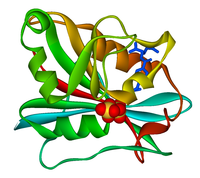
Photo from wikipedia
[FeFe] hydrogenases are highly efficient metalloenyzmes for hydrogen conversion. Their active site cofactor (the H-cluster) is composed of a canonical [4Fe-4S] cluster ([4Fe-4S]H) linked to a unique organometallic di-iron subcluster… Click to show full abstract
[FeFe] hydrogenases are highly efficient metalloenyzmes for hydrogen conversion. Their active site cofactor (the H-cluster) is composed of a canonical [4Fe-4S] cluster ([4Fe-4S]H) linked to a unique organometallic di-iron subcluster ([2Fe]H). In [2Fe]H the two Fe ions are coordinated by a bridging 2-azapropane-1,3-dithiolate (ADT) ligand, three CO and two CN− ligands, leaving an open coordination site on one Fe where substrates (H2 and H+) as well as inhibitors (e.g. O2, CO, H2S) may bind. Here, we investigate two new active site states that accumulate in [FeFe] hydrogenase variants where the cysteine (Cys) in the proton transfer pathway is mutated to alanine (Ala). Our experimental data, including atomic resolution crystal structures and supported by calculations, suggest that in these two states a third CN− ligand is bound to the apical position of [2Fe]H. These states can be generated both by “cannibalization” of CN− from damaged [2Fe]H subclusters as well as by addition of exogenous CN−. This is the first detailed spectroscopic and computational characterisation of the interaction of exogenous CN− with [FeFe] hydrogenases. Similar CN−-bound states can also be generated in wild-type hydrogenases, but do not form as readily as with the Cys to Ala variants. These results highlight how the interaction between the first amino acid in the proton transfer pathway and the active site tunes ligand binding to the open coordination site and affects the electronic structure of the H-cluster.
Journal Title: Chemical Science
Year Published: 2023
Link to full text (if available)
Share on Social Media: Sign Up to like & get
recommendations!